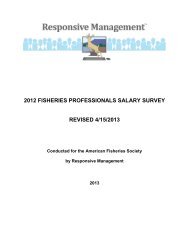Conservation Status of Crayfish Species Paddlefish Conservation ...
Conservation Status of Crayfish Species Paddlefish Conservation ...
Conservation Status of Crayfish Species Paddlefish Conservation ...
Create successful ePaper yourself
Turn your PDF publications into a flip-book with our unique Google optimized e-Paper software.
Feature:<br />
FISHERIES MANAgEMENT<br />
<strong>Paddlefish</strong> caught in gill nets in the warm waters<br />
at the beginning and end <strong>of</strong> the fishing season<br />
experience high mortality. this paddlefish<br />
(missing its rostrum) was alive (but barely)<br />
when tagged with a radio transmitter and<br />
released as bycatch; it subsequently died.<br />
Photo by Phil bettoli.<br />
protecting paddlefish from Overfishing:<br />
a Case history <strong>of</strong> the research<br />
and regulatory process<br />
aBStraCt: A commercial fishery for paddlefish (Polyodon spathula) in the<br />
Tennessee River was largely unregulated through the 1990s. Beginning in 2002,<br />
attention devoted to the plight <strong>of</strong> caviar-yielding species around the world resulted<br />
in much more scrutiny <strong>of</strong> the Tennessee paddlefish industry. This article describes<br />
the stock assessment <strong>of</strong> a paddlefish stock and the approach taken to present research<br />
findings to state and federal regulators and a skeptical fishing community. The end<br />
result for the fishery, and lessons learned from a series <strong>of</strong> public, facilitated, and<br />
state commission meetings are discussed. The need to compromise with the fishing<br />
industry meant that not all <strong>of</strong> the measures proposed to protect the fishery from<br />
overfishing were enacted; however, the fishery entered the 2006–2007 season with<br />
more regulations in place than ever before and with a promise by the regulatory<br />
commission that more restrictive regulations will be imposed in the future if<br />
warranted.<br />
protegiendo al “pez espátula” de la sobrepesca:<br />
historia de la investigación y<br />
el proceso regulatorio<br />
reSumen: La pesca comercial del “pez espátula” (Polyodon spathula) en el Río<br />
Tennessee se mantuvo sin regulación durante la década de 1990. A principios de<br />
2002, la atención dedicada a las especies productoras de caviar a nivel mundial<br />
dio como resultado un mayor escrutinio de la industria del “pez espátula” en<br />
Tennessee. En este artículo se describe la evaluación pesquera de una población<br />
de “pez espátula” y el enfoque adoptado para presentar los resultados de la<br />
investigación a las agencias estatales y federales de regulación y a la escéptica<br />
comunidad pesquera. También se discute el resultado final para la pesquería,<br />
las lecciones aprendidas por diferentes tipos de público y las reuniones de las<br />
comisiones estatales. La necesidad de compromiso con la industria pesquera<br />
significa que no se han puesto en marcha todas las medidas propuestas para evitar<br />
la sobrepesca; sin embargo, la pesquería comenzó la temporada 2006–2007 con<br />
más regulaciones que nunca antes y con la promesa de la comisión reguladora de<br />
que en el futuro se impondrá un control más estricto.<br />
phillip W. Bettoli,<br />
george d. Scholten,<br />
and Willliam C. reeves<br />
Bettoli is assistant unit leader and fisheries<br />
research scientist at the U.S. geological<br />
Survey Tennessee Cooperative Fishery<br />
Research Unit, Tennessee Technological<br />
University, Cookeville. The Unit is<br />
jointly sponsored by the Tennessee<br />
Wildlife Resources Agency, Tennessee<br />
Technological University, and the U.S.<br />
geological Survey. Bettoli can be contacted<br />
at pbettoli@tntech.edu. Scholten is<br />
reservoir and river fisheries coordinator<br />
and Reeves is fisheries chief at Tennessee<br />
Wildlife Resources Agency, Nashville.<br />
When the Convention on International<br />
Trade in Endangered and Imperiled <strong>Species</strong><br />
<strong>of</strong> Flora and Fauna (CITES) designated<br />
paddlefish (Polyodon spathula) an Appendix<br />
II species in 1992, export <strong>of</strong> their caviar fell<br />
under the regulatory authority <strong>of</strong> the U.S.<br />
Fish and Wildlife Service’s (FWS) division <strong>of</strong><br />
Management Authority (dMA). Although<br />
trade in products <strong>of</strong> any animal designated<br />
an Appendix II species is allowed under<br />
international law, CITES requires that the<br />
relevant management authority ensure that<br />
“trade will not imperil the survival <strong>of</strong> the species<br />
in the wild.” In other words, the dMA is<br />
authorized to grant export permits to paddlefish<br />
caviar wholesalers and retailers if state<br />
fisheries personnel demonstrate to the dMA<br />
that the stocks within their state boundaries<br />
are healthy enough to withstand commercial<br />
fishing.<br />
For at least a decade, dMA personnel<br />
were concerned over the number <strong>of</strong> export<br />
permits requested by purveyors <strong>of</strong> Tennessee<br />
paddlefish caviar. Tennessee was one <strong>of</strong> seven<br />
states that still allowed commercial harvest <strong>of</strong><br />
paddlefish for their roe and Tennessee <strong>of</strong>ten<br />
led the nation in the amount <strong>of</strong> paddlefish<br />
caviar exported (Marie Maltese; dMA; pers.<br />
comm.); more than 17,000 kg <strong>of</strong> wild-caught<br />
paddlefish roe were exported from the United<br />
States between 2001 and 2005 (dMA 2006).<br />
Additionally, the successful prosecution<br />
in 2002 <strong>of</strong> three Tennessee wholesalers for<br />
violations <strong>of</strong> the Lacey Act, in which more<br />
than 3,500 kg <strong>of</strong> illegally obtained paddlefish<br />
roe were seized, revealed a flourishing illegal<br />
trade in paddlefish caviar. In Tennessee, most<br />
paddlefish are harvested from Kentucky Lake,<br />
390 Fisheries • vol 32 no 8 • august 2007 • www.fisheries.org







